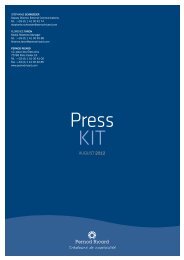Registration Document - Pernod Ricard
Registration Document - Pernod Ricard
Registration Document - Pernod Ricard
Create successful ePaper yourself
Turn your PDF publications into a flip-book with our unique Google optimized e-Paper software.
4 Notes<br />
86<br />
ANNUAL CONSOLIDATED FINANCIAL STATEMENTS<br />
to the annual consolidated fi nancial statements<br />
fair value of plan assets (termed the “corridor” method). Recognition<br />
of the provision is on a straight-line basis over the average number<br />
of remaining years’ service of the employees in the plan in question<br />
(amortisation of actuarial gains and losses). The expense recognised<br />
in respect of the benefit obligations described above incorporates:<br />
◆ expenses corresponding to the acquisition of an additional year’s<br />
rights;<br />
◆ interest cost;<br />
◆<br />
income corresponding to the expected return on plan assets;<br />
◆ income or expense corresponding to the amortisation of actuarial<br />
gains and losses;<br />
◆ past service cost; recognised on a straight-line basis over the<br />
average residual period until the corresponding benefits vest with<br />
employees;<br />
◆ income or expense related to changes to existing plans or the<br />
creation of new plans;<br />
◆ income or expense related to any plan curtailments or<br />
settlements.<br />
The expense arising from the change in net obligations for pensions<br />
and other long-term employee benefits is recognised within operating<br />
profit or within interest (expense) income on the basis of the nature<br />
of the underlying.<br />
The Group does not participate in multi-employer plans.<br />
19. Sales<br />
Revenue is measured at the fair value of the consideration received<br />
or to be received, after deducting trade discounts, volume rebates<br />
and sales-related taxes and duties. Sales are recognised when the<br />
significant risks and rewards of ownership have been transferred,<br />
generally at the date of transfer of ownership title.<br />
19.1 Cost of services rendered<br />
in connection with sales<br />
Pursuant to IAS 18 (Revenue), certain costs of services rendered in<br />
connection with sales, such as advertising programmes in conjunction<br />
with distributors, listing costs for new products and promotional<br />
activities at point of sale, are deducted directly from sales if there<br />
is no separately identifiable service whose fair value can be reliably<br />
measured.<br />
19.2 Duties and taxes<br />
In accordance with IAS 18, certain import duties, in Asia for instance,<br />
are classified as cost of sales, as these duties are not specifically<br />
re-billed to customers (as is the case for Social s ecurity stamps in<br />
France, for example).<br />
19.3 Discounts<br />
In accordance with IAS 18, early payment discounts are not considered<br />
to be financial transactions, but rather are deducted directly from<br />
sales.<br />
PERNOD RICARD<br />
20. Gross margin after logistics costs,<br />
contribution after advertising &<br />
promotion expenses, profit from<br />
recurring operations and other<br />
income and expenses<br />
Gross margin after logistics costs refers to sales (excluding duties<br />
and taxes), less cost of sales and logistics costs. The contribution<br />
after advertising and promotional expenses is the gross margin<br />
after deducting logistics, advertising and promotional costs. Profit<br />
from recurring operations is the contribution after advertising<br />
and promotional expenses less trading costs and overheads. This<br />
is the indicator used internally to measure the Group’s operational<br />
performance. It excludes other income and expenses, such as those<br />
relating to restructuring and integration, capital gains and losses<br />
on disposals and other non-recurring income and expenses. These<br />
other operating income and expenses are excluded from profit from<br />
recurring operations because the Group believes they have little<br />
predictive value due to their occasional nature. They are described in<br />
detail in Note 7.<br />
21. Deferred tax<br />
Deferred tax is recognised on temporary differences between the tax<br />
and book value of assets and liabilities in the consolidated balance<br />
sheet and is measured using the balance sheet approach. The effects<br />
of changes in tax rates are recognised in shareholders’ equity or in<br />
profit and loss in the year in which the change of tax rates is decided.<br />
Deferred tax assets are recognised in the balance sheet when it is more<br />
likely than not that they will be recovered in future years. Deferred<br />
tax assets and liabilities are not discounted. In order to evaluate the<br />
Group’s ability to recover these assets, account is notably taken of<br />
forecasts of future taxable profits.<br />
22. Share-based payment<br />
In accordance with the option provided by IFRS 1, the Group applies<br />
IFRS 2 (Share-based payment) as of 1 July 2004, to all instruments<br />
granted after 7 November 2002 and not yet fully vested at 1 July<br />
2004. The Group applies this standard to transactions whose award<br />
and settlement are share-based and to transactions whose award is<br />
share-based but which are settled in cash.<br />
In application of this standard, stock options granted to employees are<br />
measured at fair value. The amount of such fair value is recognised in<br />
profit and loss over the vesting period of the rights and a corresponding<br />
double entry is recognised as an increase in shareholders equity.<br />
Share appreciation rights, which will be settled in cash, are measured<br />
at fair value and recognised in profit and loss with a corresponding<br />
double entry to the liability incurred. This liability is remeasured at<br />
each balance sheet date until settlement.<br />
The fair value of options and rights is calculated using the binomial<br />
valuation model taking into account the characteristics of the plan<br />
and market data at the date of grant and on the basis of Group<br />
management assumptions.<br />
I REFERENCE DOCUMENT 2008/2009 I
















